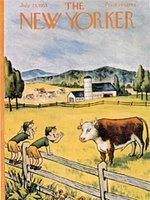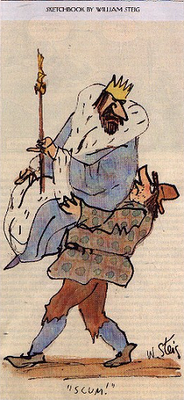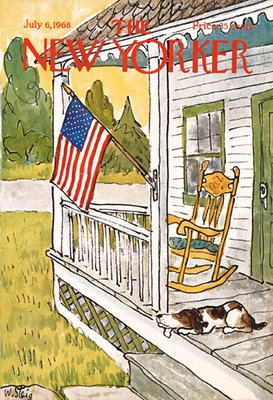William Steig, The Late and Latest Mystery Artist
As usual, it was Island Sparrow who identified the latest mystery children's author/illustrator as William Steig. What can we say, but that the lady from P.E.I. really knows her illustrators?
 William Steig was one of my children's favorite picture book authors, but they knew him mostly for Sylvester and the Magic Pebble, Dr.DeSoto, Abel's Island and others of his older books. My kids grew up before the days of Shrek, made famous by the movie, which is probably the way children today know him best.
William Steig was one of my children's favorite picture book authors, but they knew him mostly for Sylvester and the Magic Pebble, Dr.DeSoto, Abel's Island and others of his older books. My kids grew up before the days of Shrek, made famous by the movie, which is probably the way children today know him best.The very best part of William Steig's picture books are his quirky drawings, but no picture book gets by on drawings alone. The story has to be good, too, and William Steig's stories are the perfect match for his drawings: eccentric, a little silly, but heroic and philosophical, too, told in language that is literary, sophisticated, yet full of good humour. There's no dumbing down for children in William Steig's books!
His whimsical books for children were serious business to William Steig. In his Sylvester and the Magic Pebble Caldecott Award acceptance speech he says that
[a]rt, including juvenile literature, ...helps us to know life in a way that still keeps before us the mystery of things. It enhances the sense of wonder. And wonder is respect for life. Art also stimulates the adventurousness and the playfulness that keep us moving in a lively way and that lead us to useful discovery.
 Steig didn't start out doing children's books. He started out as an artist, and what he called "just drawing" was always what he liked best. But an artist has to make money, and Steig made his money as a cartoonist, most notably as a cartoonist for The New Yorker, where he was the magazine's longest-running contributor, with over one hundred cover illustrations and more than one thousand cartoons attributed to him by the time of his death in 2003 at the age of 96. His cartoons from The New Yorker are copyrighted, so I can't post one, but you can check out Man in a Deep Depression or Woman to Cat for an idea of what they were like. On the right is his The New Yorker cover from July of 1953.
Steig didn't start out doing children's books. He started out as an artist, and what he called "just drawing" was always what he liked best. But an artist has to make money, and Steig made his money as a cartoonist, most notably as a cartoonist for The New Yorker, where he was the magazine's longest-running contributor, with over one hundred cover illustrations and more than one thousand cartoons attributed to him by the time of his death in 2003 at the age of 96. His cartoons from The New Yorker are copyrighted, so I can't post one, but you can check out Man in a Deep Depression or Woman to Cat for an idea of what they were like. On the right is his The New Yorker cover from July of 1953.Steig supplemented his income from The New Yorker by doing other illustrating work, including making greeting cards. He claimed that he was the pioneer of the contemporary humourous greeting card--the first one to do anything other than sickeningly sweet and mushy Victorian type cards. He also did work drawing advertising cartoons, something that he didn't enjoy much, and that ended abruptly when he told the advertising firm he was dealing with that they were "a bunch of idiots."
But their loss is our gain, since it was partly his lost advertising income that made the invitation to try his hand at making children's books so intriguing to him. A colleague at The New Yorker, Robert Krause, was publishing children's books, and invited Steig to do one, so at sixty years old, he tried his hand at something new. The result was C B D!, a letter puzzle book, then Roland the Minstrel Pig, the book that started the storybook ball rolling, and the rest are children's literature history: Sylvester and the Magic Pebble, Amos and Boris, Caleb and Kate, Yellow and Pink, Brave Irene and many more.
Here's another Steig cartoon:

Another The New Yorker cover, this one from 1968:

And a couple of his "just drawings":
When asked about his recipe for success in children's books, Steig said,
Technorati Tags: William Steig, children's literature, children's book authors, children's book illustrators
I enjoyed my childhood.... I like to think that I've kept a little innocence. Probably I'm too dumb to do anything else.Naah. He underestimates himself, don't you think?
Technorati Tags: William Steig, children's literature, children's book authors, children's book illustrators
Labels: children's literature, mystery artist










<< Home